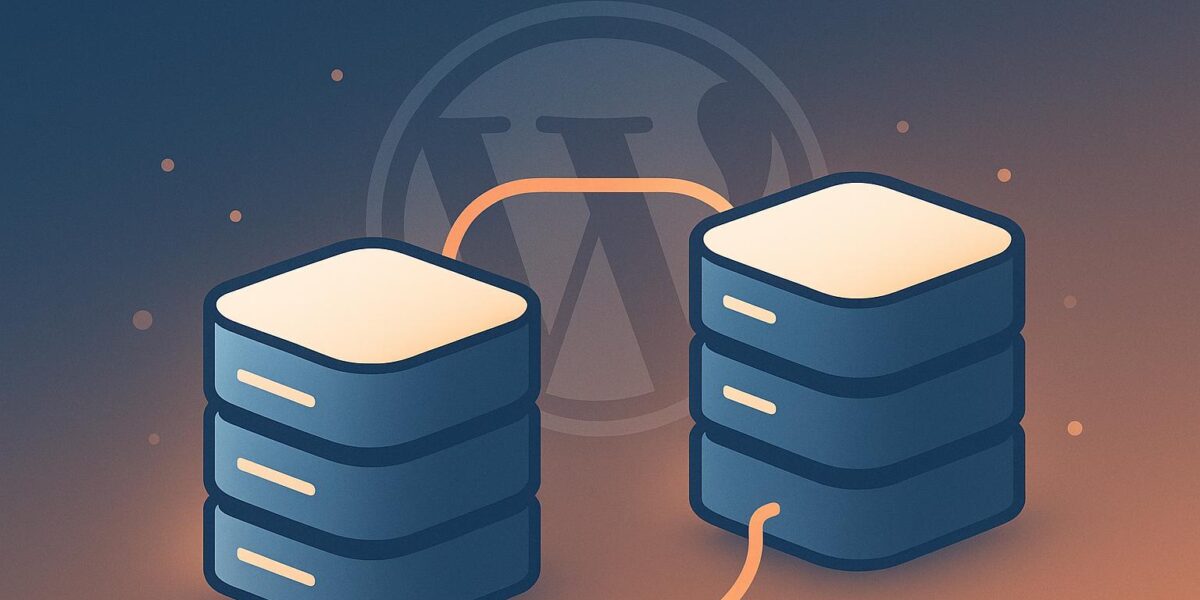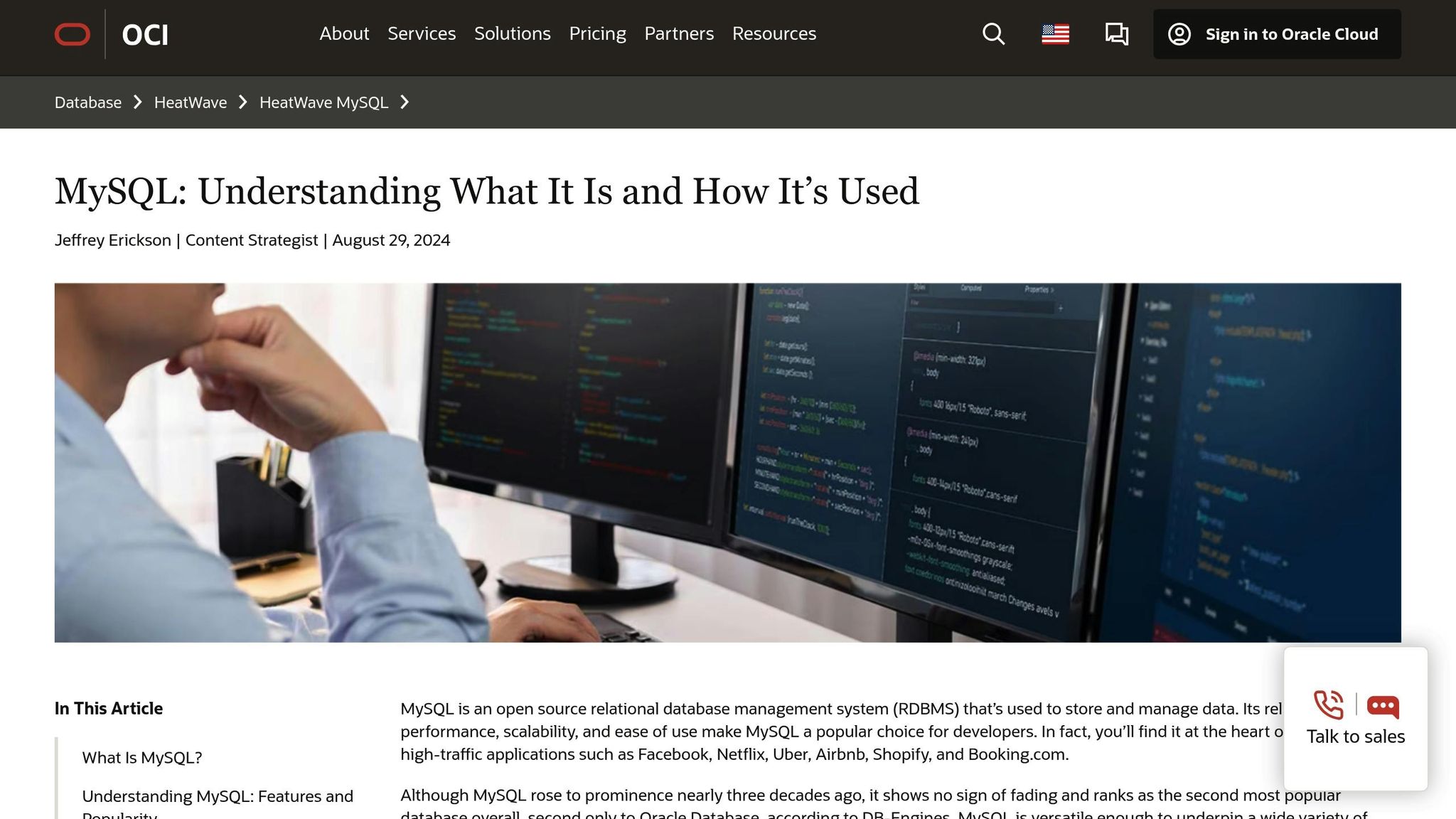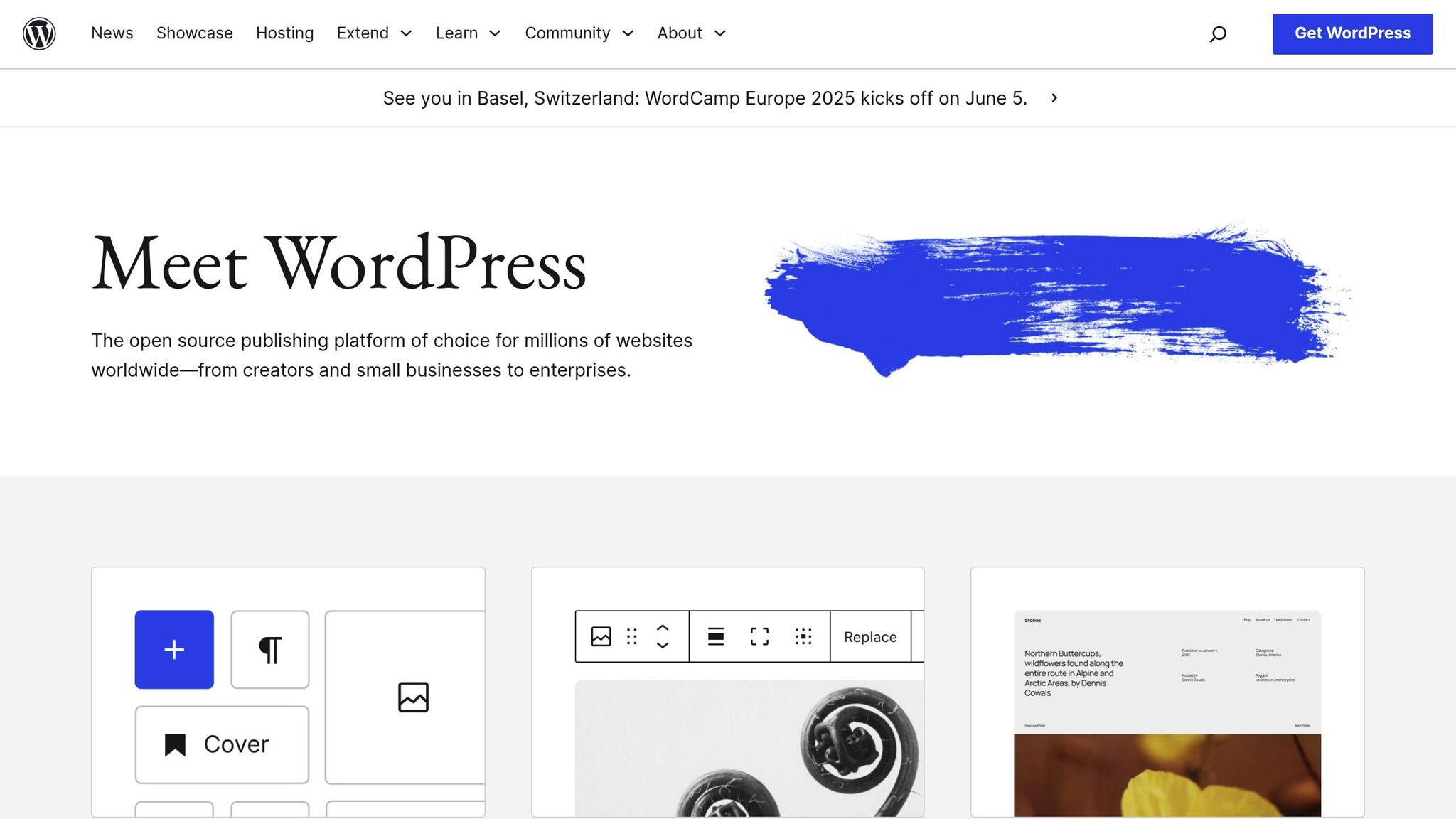MySQL Replication for WordPress: Basics

MySQL replication duplicates your WordPress database across multiple servers, improving speed, reliability, and scalability. Here’s what you need to know:
- Boost Performance: Spread read queries across replica servers to handle high traffic and reduce load on the primary server.
- Ensure Reliability: Keep data accessible during server failures with automatic failover and real-time backups.
- Save Costs: Optimize server usage, potentially cutting hosting costs by 20%–60%.
Quick Overview of MySQL Replication:

- Primary server: Handles all write operations (publishing, updates).
- Replica servers: Manage read operations (page loads, queries).
- Core components: Binary logs, relay logs, and synchronization tracking.
Key Benefits:
- Faster load times and better performance during traffic surges.
- High availability with minimal downtime.
- Scalable infrastructure for growing WordPress sites.
Challenges:
- Potential delays due to replication lag.
- Requires advanced setup and monitoring skills.
- Higher resource demands (bandwidth, storage, management).
Set up MySQL replication to improve your WordPress site’s performance and reliability. Follow this guide for step-by-step instructions and maintenance tips.
MySQL Replication System Components
Primary and Replica Server Roles
In a MySQL replication setup, the primary server is responsible for handling all write operations for the WordPress database. Meanwhile, replica servers focus solely on read operations. This division allows the primary server to manage database updates efficiently, while read queries are spread across multiple replicas. This setup ensures smoother performance and better resource allocation. The replication process ensures that data stays in sync between the servers.
How Data Moves Between Servers
Here’s how data synchronization works:
-
Binary Log Creation
The primary server records all database changes in binary log files. -
Log Shipping
Replica servers maintain an active connection to the primary server, requesting and receiving new entries from the binary logs as they are created. -
Data Application
Replica servers apply these binary log changes to their local copies of the database, keeping them synchronized with the primary server.
| Component | Function | WordPress Impact |
|---|---|---|
| Binary Logs | Record database changes | Tracks all content updates |
| Relay Logs | Temporarily store data on replicas | Ensures reliable data transfer |
| Position Tracking | Keeps synchronization in check | Prevents data inconsistencies |
Core Technical Terms
Understanding these key terms is essential to grasping the replication process:
- Replication Lag: The time delay between a change being made on the primary server and it appearing on the replicas.
- Failover: The process of switching a replica server to act as the primary server if the original primary server fails.
- Read/Write Splitting: A method where read queries are routed to replica servers, while write queries are directed to the primary server.
- Binary Log Position: A unique marker that helps track which updates have been applied on the replica servers.
Together, these components and concepts create a reliable replication system, ensuring high availability and optimized performance for WordPress sites.
Create a MySQL replica database in 4 short steps (2025)
Pros and Cons of MySQL Replication
When considering MySQL replication for WordPress sites, it’s important to weigh the benefits and challenges based on the specific needs of your setup.
Main Benefits
Better Performance
- Spreads read queries across multiple servers
- Speeds up page load times by balancing query loads
- Uses dedicated servers for reading and writing to improve efficiency
Increased Reliability
- Keeps data accessible even during server failures
- Offers failover protection to reduce downtime
- Maintains backup copies of data for added security
Scalability
- Handles growing traffic efficiently
- Allows distribution of servers across different locations
- Supports WordPress growth without major infrastructure overhauls
Common Challenges
Synchronization Delays
Network issues, replication lag, or complex queries can cause delays in syncing data, leading to occasional inconsistencies in WordPress databases.
Resource Demands
- Higher infrastructure and operational costs
- More bandwidth required for transferring data
- Extra storage needed for system logs and backups
Management Challenges
Running multiple servers requires advanced skills, more monitoring, and can complicate troubleshooting in WordPress environments.
Benefits vs. Drawbacks Overview
| Aspect | Benefits | Drawbacks |
|---|---|---|
| Performance | – Distributes load across servers – Faster read operations – Better response times |
– Possible replication lag – Bandwidth limitations – Impact of complex queries |
| Reliability | – High availability – Automatic failover – Data redundancy |
– Sync issues – Increased system complexity – More failure points |
| Maintenance | – Flexible backup options – Easier rolling updates – Geographic distribution |
– Higher operating costs – More complex monitoring – Requires advanced expertise |
Choosing MySQL replication depends on your WordPress site’s traffic, infrastructure, and resources. Larger sites often gain the most from replication, while smaller setups might struggle with the added complexity. Understanding these trade-offs is key to making the right decision for your site.
sbb-itb-d55364e
Setting Up MySQL Replication
Learn how to configure both primary and replica servers to establish reliable MySQL replication.
Primary Server Setup Steps
To prepare the primary server for replication, you’ll need to enable binary logging and configure replication parameters.
- Enable Binary Logging
Update the server configuration to enable binary logging by editing the my.cnf file:
# my.cnf configuration
server-id = 1
log_bin = /var/log/mysql/mysql-bin.log
binlog_format = ROW
- Create a Replication User
Set up a dedicated user for replication with the necessary permissions:
CREATE USER 'replication_user'@'%' IDENTIFIED BY 'secure_password';
GRANT REPLICATION SLAVE ON *.* TO 'replication_user'@'%';
FLUSH PRIVILEGES;
- Verify Binary Logging
Check the master status to confirm that binary logging is active:
SHOW MASTER STATUS;
Replica Server Setup Steps
Next, configure the replica server to connect to the primary server and start synchronization.
- Set Up Server Configuration
Modify the my.cnf file on the replica server:
# my.cnf configuration
server-id = 2
relay_log = /var/log/mysql/mysql-relay-bin
read_only = 1
- Start Replication
Point the replica to the primary server and initiate replication:
CHANGE MASTER TO
MASTER_HOST='primary_server_ip',
MASTER_USER='replication_user',
MASTER_PASSWORD='secure_password',
MASTER_LOG_FILE='mysql-bin.000001',
MASTER_LOG_POS=0;
START SLAVE;
WordPress Database Integration

Once the MySQL replication is set up, you can integrate it with your WordPress database to manage read and write operations efficiently.
Database Configuration
Update your wp-config.php file to define the primary and replica servers:
// Primary server for writes
$db['primary'] = array(
'host' => 'primary_server_ip',
'name' => 'wordpress_db',
'user' => 'wp_user',
'password' => 'secure_password'
);
// Replica server for reads
$db['replica'] = array(
'host' => 'replica_server_ip',
'name' => 'wordpress_db',
'user' => 'wp_user',
'password' => 'secure_password'
);
Query Distribution
Use the following setup to distribute queries between the primary and replica servers:
| Query Type | Server | Function |
|---|---|---|
| SELECT | Replica | Handles read-only operations like content retrieval |
| INSERT/UPDATE/DELETE | Primary | Manages write operations for data changes |
| User Sessions | Primary | Ensures consistency for logged-in users |
Monitoring and Maintenance
After integration, monitor the replication status and ensure everything runs smoothly.
- Monitor Replication Lag
Check the replication lag to ensure the replica is up to date:
SHOW SLAVE STATUS\G
- Check Query Distribution
Verify where queries are being processed:
SHOW PROCESSLIST;
- Validate Data Consistency
Run checks to confirm data integrity across servers:
CHECKSUM TABLE your_wordpress_tables;
Maintenance Guidelines
System Monitoring
Keeping an eye on your MySQL replication system is key to maintaining its performance. Regularly track important metrics like replication lag, CPU usage, disk space, and binary log status. Pay attention to thread states, connection counts, and query response times to catch problems early. Tools like MySQL Enterprise Monitor, Percona Monitoring and Management (PMM), or Prometheus (with a MySQL Exporter) can make real-time monitoring much easier.
Backup and Recovery Plans
Having a solid backup plan is critical for protecting your data. Set up an automated schedule that covers both primary and replica servers. Your backup plan should include:
- Full backups to capture the entire database.
- Binary log backups to track incremental changes.
- Configuration file backups to preserve essential settings.
To ensure your backups are reliable, conduct recovery drills, check the integrity of your backups, and clearly document recovery time objectives (RTO) along with step-by-step restoration processes. Regular testing will help you stay prepared for unexpected issues.
Professional Support Options
Managing a MySQL replication setup can get complex, and professional help can make all the difference. You might want to bring in experts when:
- Technical issues arise, such as performance bottlenecks, security concerns, replication errors, or challenges with high availability.
- Scaling up becomes necessary, whether through load balancing, query optimization, capacity planning, or infrastructure upgrades.
- Compliance is required, like meeting security standards, passing audits, or preparing for disaster recovery.
Expert guidance can help keep your MySQL replication system running smoothly and reliably, especially in demanding environments like WordPress.
Conclusion
Summary
MySQL replication plays a critical role in supporting scalable WordPress websites by keeping primary and replica databases in sync. This setup improves load times, minimizes downtime, and ensures reliable performance during traffic surges. We’ve discussed key practices like monitoring, backup strategies, and the value of professional upkeep to maintain a stable replication system. With these points in mind, it’s time to refine your implementation plan.
Next Steps
Choose a solution that matches your site’s specific needs for traffic, database size, performance, and budget. Key considerations include:
- Current and projected traffic levels
- Database size and query demands
- Performance goals
- Available budget
- Maintenance and support capabilities
This approach combines replication essentials with the practical demands of your site, ensuring a well-rounded strategy.
"Our expert team personally matches your business with hosting that actually fits your needs, budget, and goals."
For a tailored replication strategy, consult professionals who can align your goals with your site’s unique requirements. Effective replication relies on ongoing monitoring, regular maintenance, and expert guidance.
FAQs
How can MySQL replication enhance the performance and reliability of a WordPress site?
MySQL replication improves the performance and reliability of a WordPress site by creating multiple copies of your database across different servers. This setup allows read-heavy operations, like retrieving posts or comments, to be distributed across replicas, reducing the load on the primary database and speeding up response times.
Additionally, replication enhances fault tolerance. If the primary database server experiences downtime, a replica can take over as the new primary, ensuring your site remains operational with minimal disruption. This makes MySQL replication a valuable tool for scaling WordPress sites and maintaining high availability, especially for growing businesses or high-traffic websites.
What challenges can arise when setting up MySQL replication for WordPress, and how can you address them?
Setting up MySQL replication for WordPress can present a few challenges, but with proper planning, these can be effectively managed. Common issues include data inconsistency, replication lag, and configuration errors.
To address these challenges:
- Data inconsistency: Ensure the primary and replica databases are properly synced before starting replication. Regularly monitor and verify data integrity.
- Replication lag: This can occur when the replica struggles to keep up with the primary database. Optimize queries, use efficient indexing, and monitor server performance to minimize lag.
- Configuration errors: Double-check your MySQL settings and ensure the replication user has the correct permissions. Follow best practices for setting up and maintaining replication.
While MySQL replication can enhance WordPress scalability and performance, it requires careful setup and monitoring to avoid disruptions. If you’re unsure about the process, consider consulting experts to tailor a hosting solution that meets your specific needs.
How can I maintain data consistency and track replication lag in a MySQL replication setup for WordPress?
Ensuring data consistency and monitoring replication lag in a MySQL replication setup for WordPress is crucial for optimal performance and reliability. To maintain consistency, use row-based replication where possible, as it minimizes discrepancies between the master and replica databases. Regularly check for any errors in the replication process using MySQL’s built-in tools like SHOW SLAVE STATUS.
To monitor replication lag, you can use the Seconds_Behind_Master metric available in the SHOW SLAVE STATUS command. This value helps you understand how far the replica is lagging behind the master. For a more automated approach, consider setting up monitoring tools or scripts that alert you when the lag exceeds acceptable thresholds. Staying proactive with monitoring ensures smooth performance for your WordPress site.
